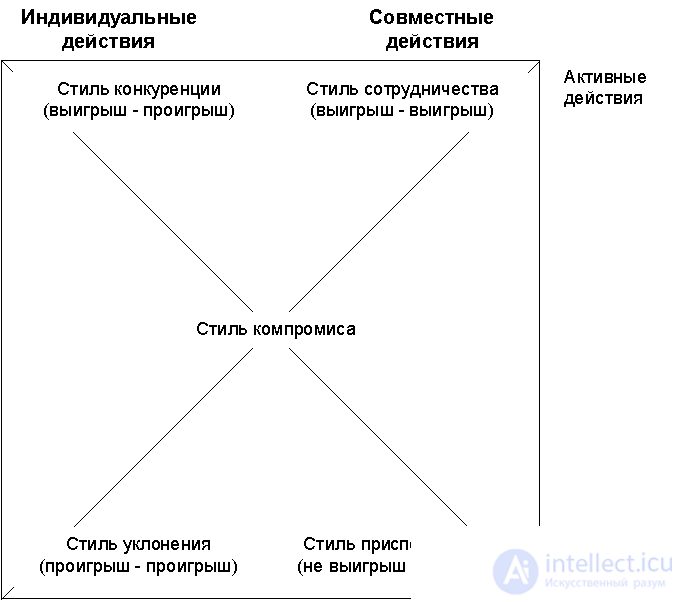Lecture
Ideally, it is believed that the manager * should not eliminate the conflict * , but manage it and use it effectively. The work of the manager is carried out in the following sequence:
Two methods are widely used to resolve organizational conflicts: structural and interpersonal.
Structural methods . These methods are associated with the use of changes in the structure of the organization to resolve conflicts that have already developed. They are aimed at reducing the intensity of the conflict. Consider the four structural methods of conflict resolution.
Clarification of work requirements. The head must clearly state to the subordinates their rights and obligations, what results are expected from each employee and department. The level of employee performance is determined by certain parameters, specifies the source and recipient of various information, the timing of its presentation, as well as clearly defined policies, procedures and rules.
Coordination and integration mechanisms. If subordinates have a disagreement on any problem, the conflict can be avoided due to the hierarchy of powers, i.e. appeals to their common boss, inviting him to make a final decision. The principle of unity of command facilitates the use of hierarchy to manage a conflict situation. The introduction of a special integration mechanism for conflicting divisions, for example, a common deputy, a curator or coordinator, merging different divisions and endowing them with a common task, creating intermediate services coordinating the work of interdependent divisions (for example, sales and production departments) helps to avoid a conflict situation.
Corporate complex goals. The idea behind these goals is to direct the efforts of all participants towards the achievement of a common goal. Thus, setting clearly defined goals for the organization as a whole will help ensure that the heads of departments make decisions that ensure the success of the activities of the entire organization.
The structure of the reward system. With rewards, one can influence people's behavior in such a way as to avoid the dysfunctional effects of conflict. At the same time, the remuneration system should be focused on encouraging people who contribute to the achievement of common goals, a comprehensive approach to solving the problem, and vice versa, to punish with a fine for non-constructive behavior.
Interpersonal methods . When you are in a conflict situation, for a more effective solution of the problem, it is necessary to choose a certain style of behavior, taking into account your style, the style of other people involved in the conflict, as well as the nature of the conflict itself. K. U. Thomas and R. H. Kilmenn identified five typical strategies (styles) of behavior in conflict situations. Their system allows you to target any person in the event of his falling into a conflict situation with a common source of conflict - the discrepancy between the interests of two or more parties.
The style of behavior of any person in conflict is determined by: a measure to satisfy their own interests; active or passive actions; measure of satisfaction of the interests of the other party; individual or joint action.
Graphically, this is depicted by means of the Thomas-Kilmenna grid, which defines the place and the name of the behavioral styles (Fig. 6. 18).

Fig. 6. 18. Styles of conflict resolution.
Based on the proposed model, there are five ways to manage conflicts:
Competition (rivalry, competition) - the resolution of the conflict by force, as the style is characterized by great personal involvement and interest in resolving the conflict, but without taking into account the positions of the other party. This is the style of "win - lose" in interpersonal conflict. To apply this style, you must have the power or physical advantages. Such a style can, in some cases, help achieve individual goals. However, in public opinion, this style is not popular.
The style of leaving the conflict is connected with the lack of personal perseverance and the desire to cooperate with others to resolve it. Here there is an attempt to stand aside from the conflict, not to assume responsibility for resolving the conflict. With this approach, both sides lose in the conflict. This style leads to disapproval of inaction on the part of others.
Conflict resolution through cooperation. As a style is characterized by a high degree of personal involvement in it, and a strong desire to cooperate with others to resolve interpersonal conflict. With this approach, both sides win. Such people are considered dynamic, others have a favorable impression of them. They correctly believe that each participant in the conflict has equal rights in resolving it and everyone’s point of view has a right to exist.
The style of adaptation leads to the position of the other side, the sacrifice of self-interest for the sake of the other side. The basis of this style is the desire to cooperate with others, but without entering into this cooperation of their strong interest. This style is like "no win - win" is positively evaluated by others, but like with weak natures.
The compromise style assumes a moderate consideration of the interests of each of the parties, and hence the need to make certain concessions. In general, this style is evaluated favorably and belongs to the type "non-win - non-win". In many situations, a compromise style allows for a quick resolution of the conflict, especially in cases where one of the parties has a clear advantage.
Thus, both parties benefit only in a situation of cooperation, when the interests of both parties are satisfied. However, this style is the most difficult, since joint decision-making requires desire, effort and time to resolve the conflict. It is the style of cooperation that leads to the optimal solution of the problem. Knowledge of these styles of conflict resolution allows everyone to consciously make one or another choice, based on the specific situation.
Comments
To leave a comment
Management
Terms: Management